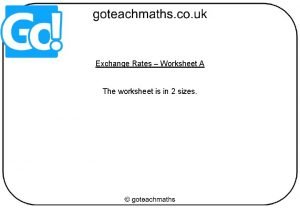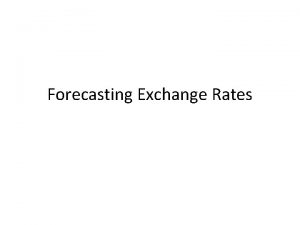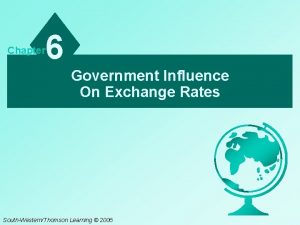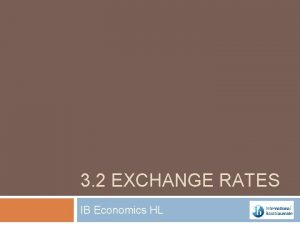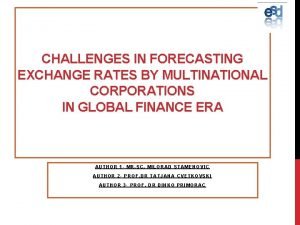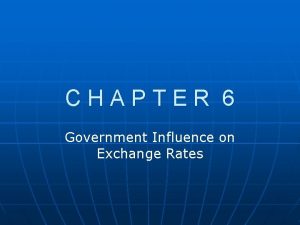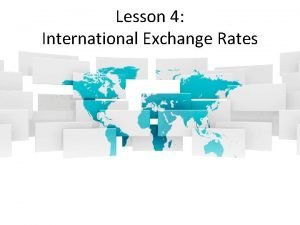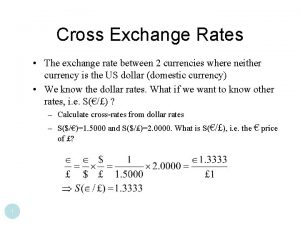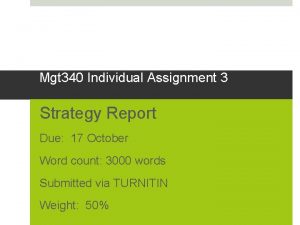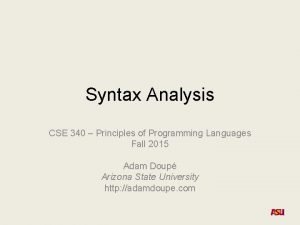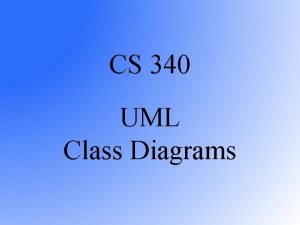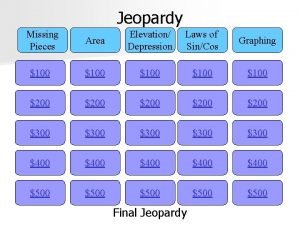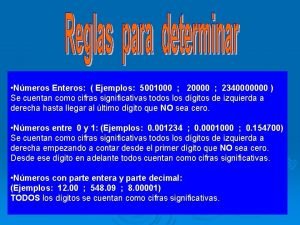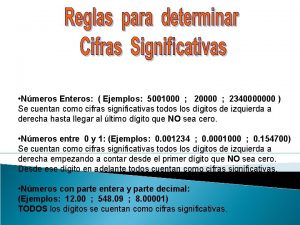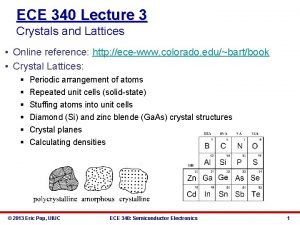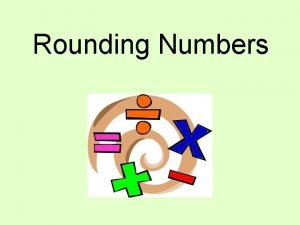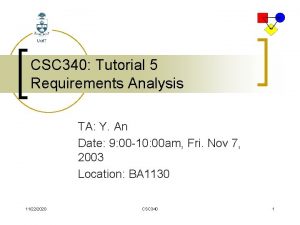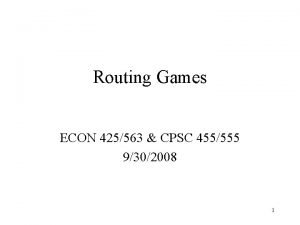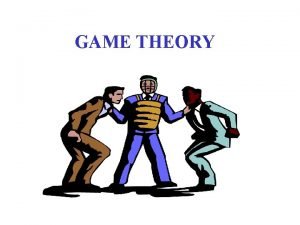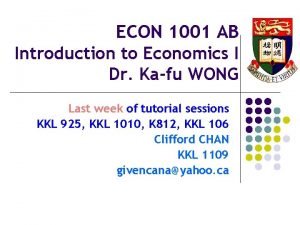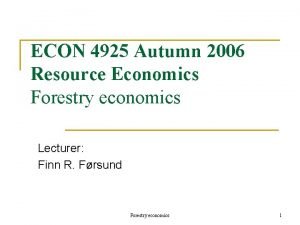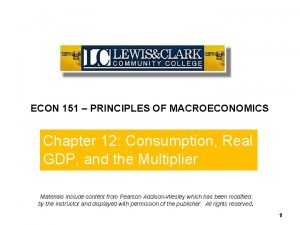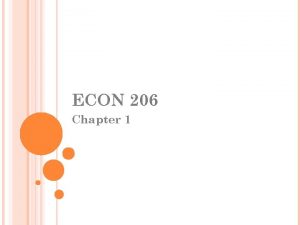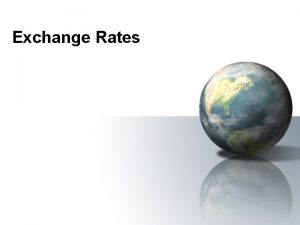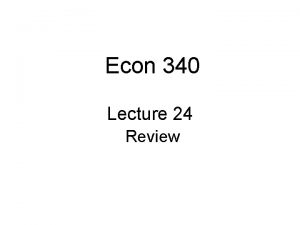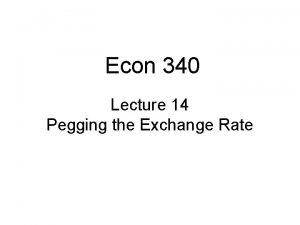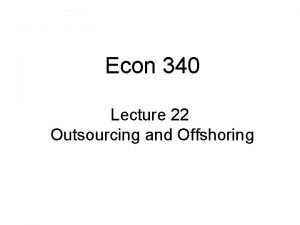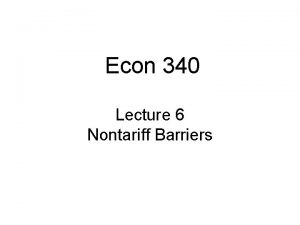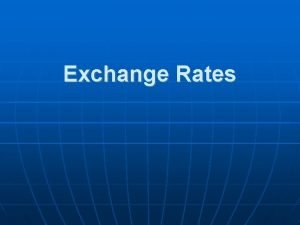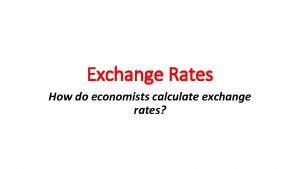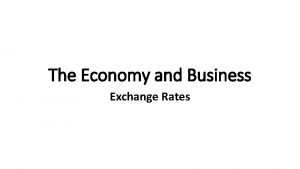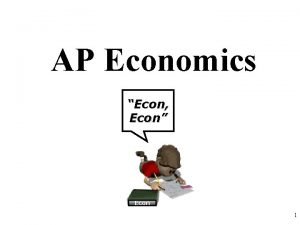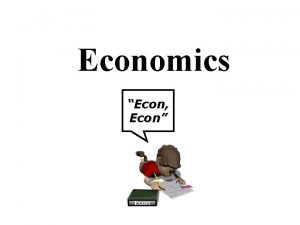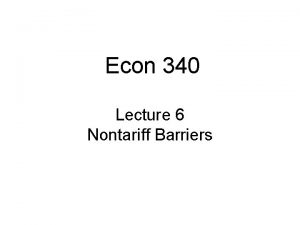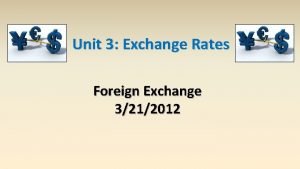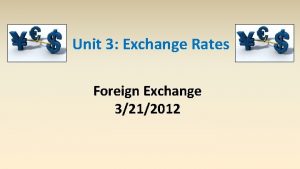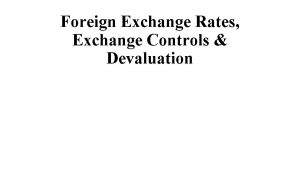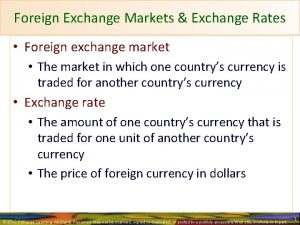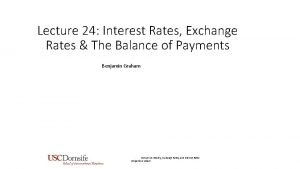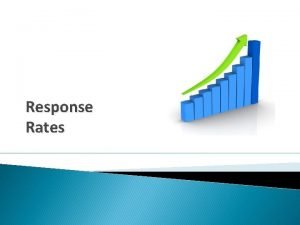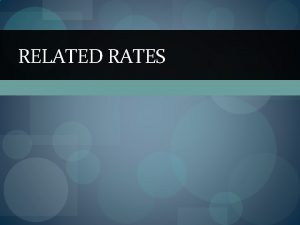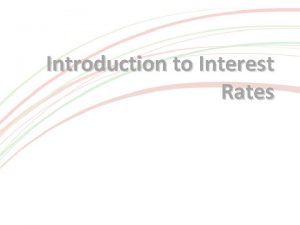Econ 340 Lecture 13 Exchange Rates Outline Exchange






























































- Slides: 62

Econ 340 Lecture 13 Exchange Rates

Outline: Exchange Rates • In What Forms Are Exchange Rates Reported? – – Bilateral Nominal Rates Multilateral (Trade-Weighted) Rates Real Rates Forward Rates • What Determines Exchange Rates? – Markets – Governments/Central Banks • Theories of Exchange Rates – Purchasing Power Parity – Asset Theory – Supply and Demand Model Econ 340, Deardorff, Lecture 13: Exchange Rates 2

Forms of Exchange Rates • What Is an Exchange Rate? – The price of one currency in terms of another – Examples • Recent rates for the US $ vs the € (euro) and ¥ (yen) were $/ € €/$ $/ ¥ ¥/$ Econ 340, Deardorff, Lecture 13: Exchange Rates Oct 22, 2019 Oct 23, 2018 1. 1150 0. 8969 0. 00921 108. 60 1. 1471 0. 8718 0. 00889 112. 44 3

Forms of Exchange Rates • What Is an Exchange Rate? – Rates are reported both ways, which can be confusing: • i. e. , “The Japanese yen rose today from 95 to 90” • Makes sense because the numbers are understood to be ¥/$, not $/¥, so the change from 95 to 90 is in fact a rise in the value of the yen Econ 340, Deardorff, Lecture 13: Exchange Rates 4

Forms of Exchange Rates • Sources of Exchange Rates – Wall Street Journal • Each day includes a table with rates for yesterday and the day before for a few dozen currencies • Also used to report forward rates and tradeweighted indexes for major currencies (see later) – IMF, online and in various publications – x-rates. com flexible tool for rates in various forms Econ 340, Deardorff, Lecture 13: Exchange Rates 5

Forms of Exchange Rates • Bilateral Nominal Exchange Rates – These are what we normally see: the actual rate between a pair of currencies • Don’t need to say “bilateral” or “nominal” except when comparing to something other than these. – Note that the size of an exchange rate means very little • Whether euro is worth more, or less, than a dollar is not important • That the yen is worth about one US cent means nothing • But see reading on “Currency Envy”. People do care! Econ 340, Deardorff, Lecture 13: Exchange Rates 6

Outline: Exchange Rates • In What Forms Are Exchange Rates Reported? – – Bilateral Nominal Rates Multilateral (Trade-Weighted) Rates Real Rates Forward Rates • What Determines Exchange Rates? – Markets – Governments/Central Banks • Theories of Exchange Rates – Purchasing Power Parity – Asset Theory – Supply and Demand Model Econ 340, Deardorff, Lecture 13: Exchange Rates 7

Forms of Exchange Rates • Multilateral Exchange Rates – Bilateral rates only tell value of a currency relative to a single other currency – If you want the overall value of a currency, you need an index relative to many others – An index requires weighting by the importance of the other currencies – Typically, multilateral exchange rates are “trade weighted” (weighted by bilateral exports and/or imports between the countries) Econ 340, Deardorff, Lecture 13: Exchange Rates 8

Trade-Weighted Dollar Index (Nominal) Ja Jan-73 Jan-75 Jan-77 Jan-89 Jan-81 Jan-83 Jan-85 Jan-87 Jan-99 Jan-91 Jan-93 Jan-95 Jan-97 Jan-09 Jan-01 Jan-03 Jan-05 Jan-07 Jan-19 Jan-11 Jan-13 Jan-15 n- 7 19 140 120 100 80 60 40 20 0 Source: Federal Reserve, “Broad Index” based on a large group of currencies, monthly data Econ 340, Deardorff, Lecture 13: Exchange Rates 9

Forms of Exchange Rates • Interpretation – From the graph, until 2002 the dollar rose relative to other currencies • By 2002 it was 4 times higher than in 1973 Trade-Weighted Dollar Index (Nominal) • Why? – We’ll see later that rates of inflation (of prices) are important for exchange rates – This suggests looking at real exchange rates, as well as nominal 140 120 100 80 60 40 20 Ja n Ja -73 n Ja -75 n Ja -77 n Ja -79 n. Ja 81 n Ja -83 n Ja -85 n Ja -87 n Ja -89 n Ja -91 n Ja -93 n. Ja 95 n Ja -97 n. Ja 99 n Ja -01 n Ja -03 n Ja -05 n Ja -07 n Ja -09 n Ja -11 n. Ja 13 n Ja -15 n 17 0 Econ 340, Deardorff, Lecture 13: Exchange Rates 10

Outline: Exchange Rates • In What Forms Are Exchange Rates Reported? – – Bilateral Nominal Rates Multilateral (Trade-Weighted) Rates Real Rates Forward Rates • What Determines Exchange Rates? – Markets – Governments/Central Banks • Theories of Exchange Rates – Purchasing Power Parity – Asset Theory – Supply and Demand Model Econ 340, Deardorff, Lecture 13: Exchange Rates 11

Forms of Exchange Rates • Real Exchange Rates – Like real wages or real incomes, a real exchange rate is simply • Corrected for inflation, or equivalently • Deflated by (i. e. , divided by) a price index – But an exchange rate involves two currencies: Whose prices do you use? • Answer: Both! Econ 340, Deardorff, Lecture 13: Exchange Rates 12

Forms of Exchange Rates • Real Exchange Rates – Let • E = €/$ be the euro/dollar nominal exchange rate • Pe = price level (index) in Europe (€ per EU-good) • Pu = price level (index) in US ($ per US-good) – Then Real Exchange rate is =(€/$) ($/US-good)/(€/EU-good) R = EPu/Pe = (EU-good/US-good) – Note that this divides each currency by its own price level: R= (€/$)(Pu/Pe) = (€/Pe) / ($/Pu) Econ 340, Deardorff, Lecture 13: Exchange Rates 13

Trade-Weighted Dollar Index (Real) Ja Jan-73 Jan-75 Jan-77 Jan-89 Jan-81 Jan-83 Jan-85 Jan-87 Jan-99 Jan-91 Jan-93 Jan-95 Jan-97 Jan-09 Jan-01 Jan-03 Jan-05 Jan-07 Jan-19 Jan-11 Jan-13 Jan-15 n- 7 19 140 120 100 80 60 40 20 0 Source: Federal Reserve, “Broad Index” based on a large group of currencies, monthly data. Econ 340, Deardorff, Lecture 13: Exchange Rates 14

Forms of Exchange Rates • Real Exchange Rates – From the graph, note that • The rise in the dollar 1973 -2002 was not real • Decline of the dollar after 2002 was real • So was the brief rise (during. Trade-Weighted the crisis), then Dollar and Index (Real) fall • And so was the rise after mid-2014 • And the fall during 2017 and rise during 2018 • But the real value of the dollar today is not unusually low or high 140 120 100 80 60 40 20 Ja n Ja -73 n Ja -75 n Ja -77 n Ja -79 n. Ja 81 n Ja -83 n Ja -85 n Ja -87 n Ja -89 n. Ja 91 n Ja -93 n Ja -95 n Ja -97 n. Ja 99 n Ja -01 n. Ja 03 n Ja -05 n Ja -07 n. Ja 09 n Ja -11 n Ja -13 n Ja -15 n 17 0 – It is basically at its long-term average Econ 340, Deardorff, Lecture 13: Exchange Rates 15

Trade-Weighted Dollar Index (Real) Ja Jan-73 Jan-75 Jan-77 Jan-89 Jan-81 Jan-83 Jan-85 Jan-87 Jan-99 Jan-91 Jan-93 Jan-95 Jan-97 Jan-09 Jan-01 Jan-03 Jan-05 Jan-07 Jan-19 Jan-11 Jan-13 Jan-15 n- 7 19 140 120 100 80 60 40 20 0 Source: Federal Reserve, “Broad Index” based on a large group of currencies, monthly data. Econ 340, Deardorff, Lecture 13: Exchange Rates 16

Outline: Exchange Rates • In What Forms Are Exchange Rates Reported? – – Bilateral Nominal Rates Multilateral (Trade-Weighted) Rates Real Rates Forward Rates • What Determines Exchange Rates? – Markets – Governments/Central Banks • Theories of Exchange Rates – Purchasing Power Parity – Asset Theory – Supply and Demand Model Econ 340, Deardorff, Lecture 13: Exchange Rates 17

Forms of Exchange Rates • Forward Exchange Rates – These are rates of exchange for later, not today • (Rates for exchange today are called “spot rates. ” That’s what we’ve been looking at so far. ) • In a forward market, no money changes hands today; a forward exchange is a contract, for both buyer and seller to transact on m m o c t Mos – 1 month from now ts; c a r t n o c forward d to be – 3 months from now e s u s e t a r – 6 months from now SJ W n i d e report Econ 340, Deardorff, Lecture 13: Exchange Rates 18

Forms of Exchange Rates • Forward Exchange Rates – Example (from WSJ) for 3/3/14: Spot 1 Month Forward 3 Month Forward US$/A$ 0. 8937 0. 8917 0. 8882 US$/Sfr 1. 1323 1. 1326 1. 1332 6 Month Forward 0. 8828 1. 1342 Here, the Australian $ costs (today) less for future delivery than for spot delivery. That is, it is selling at a “forward discount”. The Swiss franc costs more for future delivery than spot, and so is at a “forward premium. ” – Each maturity is a separate market. Econ 340, Deardorff, Lecture 13: Exchange Rates 19

Source: Werner Antweiler, Sauder School of Business, University of British Columbia Econ 340, Deardorff, Lecture 13: Exchange Rates 20

Forms of Exchange Rates • Forward Exchange Rates – Who uses the forward market, and why? • Traders, who wish to “hedge” (i. e. , avoid risk) • Speculators, who wish to bet that the spot rate will change (i. e. , they take on risk) • There also specialists who make a profit from discrepancies involving the forward rate, the spot rate, and interest rates in the two countries; this is called “covered interest arbitrage” Econ 340, Deardorff, Lecture 13: Exchange Rates 21

Clicker Question The statement “the yen rose today from 121 to 117” makes sense because a) These numbers are indexes, defined relative to a base of 100 b) The yen is a reserve currency c) The U. S. gains when Japan loses ✓ d) These numbers measure yen per dollar, not dollars per yen e) These numbers refer to time of day that the change took place

Clicker Question A “multilateral exchange rate” is a) The average exchange rate of a group of countries with different currencies b) The average exchange rate of a group of countries that share a single currency, such as the euro ✓ c) An index of the value of a country’s currency relative to several other currencies d) A measure of how much a country’s currency value has changed, on average, over multiple years e) An exchange rate agreed upon between a country and an institution such as the IMF

Clicker Question If you were to buy Japanese yen using US dollars on the 90 -day forward market, you would a) b) c) ✓ d) e) Pay dollars now but receive yen in 90 days Receive yen now but pay dollars in 90 days Pay dollars now and receive yen now Pay dollars in 90 days and receive yen in 90 days Be breaking the law of international finance

Outline: Exchange Rates • In What Forms Are Exchange Rates Reported? – – Bilateral Nominal Rates Multilateral (Trade-Weighted) Rates Real Rates Forward Rates • What Determines Exchange Rates? – Markets – Governments/Central Banks • Theories of Exchange Rates – Purchasing Power Parity – Asset Theory – Supply and Demand Model Econ 340, Deardorff, Lecture 13: Exchange Rates 25

What Determines Exchange Rates? • Two things determine exchange rates: – Markets; i. e. , supply and demand • Like any other price • We’ll look at the markets later today – Governments and/or Central Banks • This is true IF they intervene in the markets, which they often do • We’ll look at such intervention in the next lecture Econ 340, Deardorff, Lecture 13: Exchange Rates 26

What Determines Exchange Rates? • We’ll look at 3 theories of exchange rates: – PPP = Purchasing Power Parity • Very useful, but mostly wrong • Works best, if ever, only in the very long run – Asset Theory (not in textbook) • Always right! But useless – Supply and Demand Model • Best for understanding what has happened • Not much help in predicting the future (Nothing is much help in predicting! We’ll see why. ) Econ 340, Deardorff, Lecture 13: Exchange Rates 27

Outline: Exchange Rates • In What Forms Are Exchange Rates Reported? – – Bilateral Nominal Rates Multilateral (Trade-Weighted) Rates Real Rates Forward Rates • What Determines Exchange Rates? – Markets – Governments/Central Banks • Theories of Exchange Rates – Purchasing Power Parity – Asset Theory – Supply and Demand Model Econ 340, Deardorff, Lecture 13: Exchange Rates 28

Purchasing Power Parity • The PPP Theory: Exchange rate reflects relative purchasing powers of two currencies – If one country’s prices are rising faster than another’s, then the currency of the first should depreciate: – As a country’s goods get more expensive, its currency should get less expensive • Thus keeping it competitive Econ 340, Deardorff, Lecture 13: Exchange Rates 29

Purchasing Power Parity • The Prediction of PPP: – For the bilateral exchange rate between currencies of two countries, A and B A’s rate of currency depreciation = A’s rate of price inflation minus B’s rate of price inflation Econ 340, Deardorff, Lecture 13: Exchange Rates 30

Purchasing Power Parity • PPP is used to guess whether a currency is “Overvalued” (i. e. , worth more than it “should be”) or “Undervalued” (worth less than it “should be”) • E. g. , if a currency has not depreciated in spite of the country having higher inflation than others, we say that its currency is now overvalued Econ 340, Deardorff, Lecture 13: Exchange Rates 31

Purchasing Power Parity • Implication of PPP: The Real Exchange Rate should be constant • Recall: R = EPu/Pe where E = €/$ • If E falls at the same rate that the rise in Pu exceeds the rise in Pe, then R is constant • Does it work? Look again at graph of real value of the dollar… Econ 340, Deardorff, Lecture 13: Exchange Rates 32

Trade-Weighted Dollar Index (Real) P PP ls i a f Trade-Weighted Dollar Index (Real) Pr es tor ed Departures from PPP last several years Ja Jan-73 Jan-75 Jan-77 Jan-89 Jan-81 Jan-83 Jan-85 Jan-87 Jan-99 Jan-91 Jan-93 Jan-95 Jan-97 Jan-09 Jan-01 Jan-03 Jan-05 Jan-07 Jan-19 Jan-11 Jan-13 Jan-15 n- 7 19 140 120 100 80 60 40 20 0 PP Source: Federal Reserve, “Broad Index” based on a large group of currencies, monthly data Econ 340, Deardorff, Lecture 13: Exchange Rates 33

Purchasing Power Parity • Which Prices Should One Use for PPP? – Most would say to use the CPI = Consumer Price Index – The Economist (for fun) uses the price of the Mac. Donald’s Big Mac hamburger • See reading: “The Big Mac Index” July 2019 • The message here: price of the Big Mac can be an indicator of whether a currency is over- or under-valued. – The Big Mac costs more than in the US in only a few countries, which suggests that the US dollar is over-valued. – In an earlier report, they noted that, measured in burgers, US GDP was 3, 682 billion and China’s GDP was 3, 931 billion. Thus China’s economy was already larger than the US, measured in burgers, because the burger was cheaper there. Econ 340, Deardorff, Lecture 13: Exchange Rates 34

Currencies from Big Mac Index July 2018 (similar to 2019, but easier to display) Econ 340, Deardorff, Lecture 13: Exchange Rates 35

Purchasing Power Parity • Another message also from an earlier report of the Big Mac Index: – Exchange rates of poor countries tend to be low, compared to PPP, while those of rich countries tend to be high. • Reason: prices of some goods, including hamburgers, depend heavily on local inputs (rents, wages) that tend to be lower in poor countries. • Therefore it is best to only compare countries with similar incomes. • You can get a sense of that from several above. • Also, see the following graph from July 2011: Econ 340, Deardorff, Lecture 13: Exchange Rates 36

Econ 340, Deardorff, Lecture 13: Exchange Rates 37

Clicker Question Based on the graphs of US exchange rates in this lecture, when has the US dollar been most overvalued relative to Purchasing Power Parity? a) ✓ b) c) d) e) 1973 1985 2001 2017

Outline: Exchange Rates • In What Forms Are Exchange Rates Reported? – – Bilateral Nominal Rates Multilateral (Trade-Weighted) Rates Real Rates Forward Rates • What Determines Exchange Rates? – Markets – Governments/Central Banks • Theories of Exchange Rates – Purchasing Power Parity – Asset Theory – Supply and Demand Model Econ 340, Deardorff, Lecture 13: Exchange Rates 39

Asset Theory of the Exchange Rate • The Asset Theory: Exchange rate adjusts to eliminate the motive to shift assets between currencies – Reason: Attempts to move assets quickly would swamp the market Econ 340, Deardorff, Lecture 13: Exchange Rates 40

Asset Theory of the Exchange Rate • The Asset Theory: – Implication Exchange rate must already be whatever people think it is about to be – Reason: If it were not, then • Huge amounts of money would try to flow toward the currency that is expected to appreciate • Market would be in disequilibrium (D>S) • Exchange rate would instantly appreciate until it equaled what people expected Econ 340, Deardorff, Lecture 13: Exchange Rates 41

Asset Theory of the Exchange Rate • The Asset Theory: – Implications: • Rates change whenever expectations of rates change • Rates are very volatile • Rates do respond to normal economic forces (like shifts in supply and demand below), – but they respond as soon as those forces are expected, – they don’t wait for the shifts themselves. • Rates also respond to “investor psychology, ” which may be irrational (e. g. , herd behavior) Econ 340, Deardorff, Lecture 13: Exchange Rates 42

Outline: Exchange Rates • In What Forms Are Exchange Rates Reported? – – Bilateral Nominal Rates Multilateral (Trade-Weighted) Rates Real Rates Forward Rates • What Determines Exchange Rates? – Markets – Governments/Central Banks • Theories of Exchange Rates – Purchasing Power Parity – Asset Theory – Supply and Demand Model Econ 340, Deardorff, Lecture 13: Exchange Rates 43

Supply and Demand Model of the Market for Foreign Exchange • Market is for two currencies, so it is arbitrary which currency we consider as – the one that is being traded, and – the one that is being used to pay for it Econ 340, Deardorff, Lecture 13: Exchange Rates 44

Supply and Demand Model of the Market for Foreign Exchange • To fix these, we will consider the market from the perspective of a domestic country – Trading a foreign currency – Paid for with its own currency – Hence it really is the market foreign exchange Econ 340, Deardorff, Lecture 13: Exchange Rates 45

Supply and Demand Model of the Market for Foreign Exchange • We say foreign “exchange” rather than foreign “currency” – This is not the market for holding currency, such as you studied in Econ 102 (e. g. , the Money Market) – It is the market for exchanging one currency for another, • usually with the intention of using the acquired currency to buy goods or other assets, not to hold it. Econ 340, Deardorff, Lecture 13: Exchange Rates 46

Supply and Demand Model of the Market for Foreign Exchange • In graphs below, – own currency is $ and – foreign currency is € – Thus it is the market for (foreign currency) € in terms of (home currency) $ • But – you should be able to do this with any two currencies – Including having the dollar as another country’s foreign currency Econ 340, Deardorff, Lecture 13: Exchange Rates 47

Supply and Demand Model of the Market for Foreign Exchange (E P Ex Eq xc ri u ce ch il h a an ibr ng of i ge um e € Ra = Ra te te ) E = $/€ S€ = Supply of € E 0 D€ = Demand for € Q€ = Quantity of € Econ 340, Deardorff, Lecture 13: Exchange Rates 48

Supply and Demand Model of the Market for Foreign Exchange • Sources of Supply of € – US Exports (i. e. , Europe’s imports) – US Capital Inflows (i. e. , Europe’s outflows) – Other • US investment income receipts • Transfers into US • Etc. – (Thus, all credits in the Balance of Payments) Econ 340, Deardorff, Lecture 13: Exchange Rates 49

Supply and Demand Model of the Market for Foreign Exchange • Sources of Demand for € – US Imports (i. e. , Europe’s exports) – US Capital Outflows (i. e. , Europe’s inflows) – Other • US investment income payments • Transfers out • Etc. – (Thus all debits in the Balance of Payments) Econ 340, Deardorff, Lecture 13: Exchange Rates 50

Supply and Demand Model of the Market for Foreign Exchange • Use of the model – Figure out how an event will change one or more of these sources of supply and demand – Shift the curve or curves accordingly – Read from the diagram what happens to the exchange rate Econ 340, Deardorff, Lecture 13: Exchange Rates 51

Supply and Demand Model of the Market for Foreign Exchange • Use of the model – Note that the price in the diagram, E=$/€, is the price of foreign currency, not the dollar – Thus if E rises, that is a dollar depreciation if E falls, that’s a dollar appreciation – This can be confusing. Remember, this is the market for, and E is the price of, foreign exchange Econ 340, Deardorff, Lecture 13: Exchange Rates 52

Supply and Demand Model of the Market for Foreign Exchange • Implications of the Model – US Tariff Increase on lots of goods (e. g. , Nixon’s 10% surcharge on imports in 1971 or a broad tariff increase now to add jobs) • Reduces demand for imports • Reduces demand for € • Shifts D€ left Econ 340, Deardorff, Lecture 13: Exchange Rates 53

• US Tariff Increase E = $/€ S € 0 E 1 D € 0 • Causes dollar to appreciate • (which hurts. Econexports) 340, Deardorff, Lecture 13: Exchange Rates Q€ 54

Supply and Demand Model of the Market for Foreign Exchange • Implications of the Model – Could apply to Trump’s tariffs, especially on China. • Model says dollar should appreciate. • It did over the last two years: Econ 340, Deardorff, Lecture 13: Exchange Rates 55

Renminbi per dollar: Sep 2018 Sep 2019 Sep 2017 Source: X-Rates. com Econ 340, Deardorff, Lecture 13: Exchange Rates 56

Supply and Demand Model of the Market for Foreign Exchange • Implications of the Model – US Interest Rate Increase • • Makes US bonds more attractive Causes increased capital inflow to US Increases demand for $ and thus supply of € Shifts S€ right – This also causes the $ to appreciate • As it has done recently, with the Fed raising interest rates • Though just lately (today? ) it has reduced them Econ 340, Deardorff, Lecture 13: Exchange Rates 57

• US Interest Rate Increase E = $/€ S € 0 S € 1 E 0 E 1 D € 0 • Causes dollar to appreciate Econ 340, Deardorff, Lecture 13: Exchange Rates Q€ 58

Supply and Demand Model of the Market for Foreign Exchange • Implications of the Model – Other examples of changes that will also cause the US dollar to appreciate (you should be able to argue and demonstrate these also): • • Increase in demand for US exports Fall in foreign interest rates Increase in perceived riskiness of foreign assets Fall in US transfer payments to foreigners – Opposites of all these will cause dollar to depreciate Econ 340, Deardorff, Lecture 13: Exchange Rates 59

Clicker Question Which of the following would cause the Mexican peso to depreciate? a) A US tariff on Mexican exports b) A decrease in remittances from US to Mexico by immigrants from Mexico c) A rise in the US interest rate ✓ d) All of the above e) None of the above

Clicker Question Suppose that Canada were to experience a burst of inflation, prices there suddenly rising faster than in the US. Which of the exchange-rate theories would predict that the Canadian dollar would fall in value relative to the US dollar? a) b) c) ✓ d) e) Purchasing Power Parity Asset Theory PPP predicts it most directly, but the rise in Canadian prices will Supply and demand reduce demand for Canadian exports and thus demand for its All of the above currency. And asset holders will None of the above understand this too, and expect depreciation. So all three predict the same.

Next Time • Pegging the Exchange Rate – How it’s done – Who does it – Effects of pegging Econ 340, Deardorff, Lecture 13: Exchange Rates 62
 Ratios rates and unit rates
Ratios rates and unit rates Unit rate vocabulary
Unit rate vocabulary Ratios guided notes
Ratios guided notes Ratios rates and unit rates
Ratios rates and unit rates 01:640:244 lecture notes - lecture 15: plat, idah, farad
01:640:244 lecture notes - lecture 15: plat, idah, farad Heathrow exchange rates
Heathrow exchange rates The main approaches to forecasting exchange rates are
The main approaches to forecasting exchange rates are Graphing exchange rates
Graphing exchange rates Government influence on exchange rates
Government influence on exchange rates Ib economics exchange rates
Ib economics exchange rates Currency forcast
Currency forcast Government intervention in exchange rates
Government intervention in exchange rates Exchange rates lesson
Exchange rates lesson Market-based forecasting of exchange rates
Market-based forecasting of exchange rates Exchange rate maths literacy
Exchange rate maths literacy Cross rate
Cross rate Qqnqq
Qqnqq Lecture outline example
Lecture outline example Lecture outline example
Lecture outline example Lecture outline meaning
Lecture outline meaning Lecture outline example
Lecture outline example Mgt340 group assignment
Mgt340 group assignment Uiuc ece 340
Uiuc ece 340 124 ucas points
124 ucas points Asu cse 340
Asu cse 340 Uiuc ece 340
Uiuc ece 340 Viksund 340 st cruz
Viksund 340 st cruz Class diagram uml example
Class diagram uml example Csc 340
Csc 340 From a point 340 from the base of hoover dam
From a point 340 from the base of hoover dam Oba-340
Oba-340 Mos capacitor c-v curve
Mos capacitor c-v curve Ece 340
Ece 340 Adam doupe cse 340
Adam doupe cse 340 Cse 340 asu
Cse 340 asu 2,340,000,000
2,340,000,000 340 bce
340 bce Vorwandmontage fenster
Vorwandmontage fenster Oba-340
Oba-340 Favorecimento real
Favorecimento real Cse 340 principles of programming languages
Cse 340 principles of programming languages Uninstalled materials asc 606
Uninstalled materials asc 606 3253/340
3253/340 System design tutorial
System design tutorial 2,340,000,000
2,340,000,000 Codigo 340
Codigo 340 Cse 340 principles of programming languages
Cse 340 principles of programming languages Szkoła podstawowa nr 340 warszawa
Szkoła podstawowa nr 340 warszawa Ece 340
Ece 340 Oba-340
Oba-340 Ece 340 uiuc
Ece 340 uiuc Adam doupe cse 340
Adam doupe cse 340 Rounding numbers 5
Rounding numbers 5 Csc 340
Csc 340 Quote sandwich
Quote sandwich Econ
Econ What is game theory
What is game theory Econ
Econ Fiscal policy ib definition
Fiscal policy ib definition Econ
Econ Monopoly in economics
Monopoly in economics Determinants of consumption
Determinants of consumption Econ 206
Econ 206





